Luckily, I quite like to cook. I even like the prep work. Granted, I do it while listening to a book on Audible or watching an old TV show (Magnum P.I., anyone? #GuiltyPleasures), but it’s a sort of Zen thing for me.
My biggest issue usually revolves around timing and meats. I have a lot of meat in the freezer and – usually at Crossfit that morning – I figure out what fresh veg I have in the fridge and what will go with what … et voila, that’s What’s For Dinner.
And therein lies the problem.
I usually haven’t defrosted anything – and am often going from Crossfit to errands to clients … and  once I get home, it’s too late to defrost the meat other than in the evil microwave. (NOTE: I’ve been trying to avoid the microwave after listening to Dave Asprey’s interview on Fat Burning Man and how microwave cooking denatures food. I haven’t quite thrown the machine out the window, but I’m trying to pay more attention.)
once I get home, it’s too late to defrost the meat other than in the evil microwave. (NOTE: I’ve been trying to avoid the microwave after listening to Dave Asprey’s interview on Fat Burning Man and how microwave cooking denatures food. I haven’t quite thrown the machine out the window, but I’m trying to pay more attention.)
If I actually do get the meat out of the freezer in the morning, I often get home and am tearing my hair out trying to “time” the cooking of the different pieces of the meal. I often wind up with one or the other thing over/underdone.
I’m a big supporter of pressure cookers for “what they do well” – I asked for one for my last birthday present, in fact.
 But a pressure cooker (or a slow cooker/Crockpot) still applies heat directly to the food that you’re cooking. So you can find yourself burning whatever you’re cooking, because you didn’t put in enough liquid, or with something too watery, because you put in too much, or with something that’s mush/too dense/etc.
But a pressure cooker (or a slow cooker/Crockpot) still applies heat directly to the food that you’re cooking. So you can find yourself burning whatever you’re cooking, because you didn’t put in enough liquid, or with something too watery, because you put in too much, or with something that’s mush/too dense/etc.
Because cooking with applied heat changes the food, and liquid evaporates.
Besides, you aren’t going to Crockpot or pressure cook a steak, or a pork tenderloin, or a flaky piece of perfect fish.
Enter the sous vide.
Sous vide (pronounced soo-veed) means “under vacuum” in French. The sous vide cooking technique involves cooking food in pouches that all the air has been squeezed out of. The fancy ones have vacuum sealers for the pouches – I just use Ziplocs. (NOTE: Don’t throw the hate on me about Ziplocs – pick your toxin. THIS ARTICLE made me feel that using BPFA-free Ziplocs wasn’t going to kill me.)
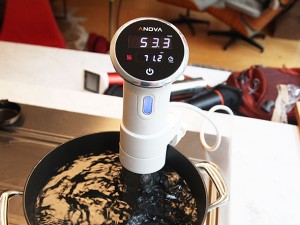 To cook sous vide, you submerge the pouch in a water bath that is held at a precisely controlled temperature with an immersion circulator/heater.
To cook sous vide, you submerge the pouch in a water bath that is held at a precisely controlled temperature with an immersion circulator/heater.
The end result? Perfectly cooked food.
Beneficial nutrients found in food are retained in the pouches, compared to traditional cooking methods where nutrients either evaporate or are left in the pan. The natural flavor and juices of the food – as well as any marinade, etc. that you add – are infused into the food while in the cooking pouch.

I supported Anova on Kickstarter a while back, after taking a one day cooking course that included “gadgets” – a smoke infuser, sous vide, etc.
Anova makes a sous vide for home use that is basically a stick that you place into a pot of water (you can see it in the photo above).
Use your phone or the top of the machine to dial in the temperature that you want the “stick” to get the water to and hold it at. It has a pump that circulates the water, and once the water is up to the temperature you set, it holds the water at that temperature.
You just have to figure out what temperature you want, to get the optimal result for the food you are cooking… and dial in that water temperature. Plop in the baggie’d food – the sous vide does the rest.
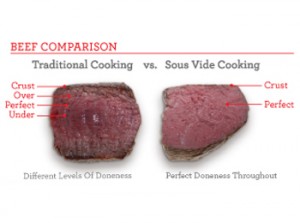 As an example, a perfect rare steak is 120 degrees. The sous vide will bring the meat to 120 all the way through, and hold it there all day long. If you were to cook that steak the usual way, you would have 120 degrees somewhere near the middle (if you use a cooking thermometer). But since the steak cooks from the pan “in,” the outside will be a higher temperature than the inside, in a gradient that goes from the char outside to about 120 near the middle, and sometimes the middle is underdone. You will also lose volume, as some of the liquid in the steak will evaporate while you cook it.
As an example, a perfect rare steak is 120 degrees. The sous vide will bring the meat to 120 all the way through, and hold it there all day long. If you were to cook that steak the usual way, you would have 120 degrees somewhere near the middle (if you use a cooking thermometer). But since the steak cooks from the pan “in,” the outside will be a higher temperature than the inside, in a gradient that goes from the char outside to about 120 near the middle, and sometimes the middle is underdone. You will also lose volume, as some of the liquid in the steak will evaporate while you cook it.
If you don’t use a cooking thermometer, who knows what you’ll get?
And what if your attention is diverted for a minute or two, in either case? (“Honey, are you sure you don’t like it medium-well?”)
 So let’s say that I am going to cook that same steak in the sous vide. I take it out of the freezer, where either it’s in a vacuum pack from the “half a cow” I purchased, or it’s in a Ziploc I put it in from the grocery store, with the air pushed totally out of it. I plop the bag into the pot of water, crank the Anova up to 120 degrees, and head out to Crossfit and work.
So let’s say that I am going to cook that same steak in the sous vide. I take it out of the freezer, where either it’s in a vacuum pack from the “half a cow” I purchased, or it’s in a Ziploc I put it in from the grocery store, with the air pushed totally out of it. I plop the bag into the pot of water, crank the Anova up to 120 degrees, and head out to Crossfit and work.
Oh sure, some chefs are cringing in horror – I’m sure that defrosting it slowly is the way to go – but what can I tell you? That’s honestly how I do it.
I get home, and make everything else that is for din-din that day. After all the sides are done, I put them into the oven on warm with the two dinner plates. Last, I heat up a cast iron pan smokin’ hot with some coconut oil and pink Himalayan salt in it. I take the steak out of the Ziploc, maybe put some oregano on it (I’m eschewing black pepper since I’m doing the Bulletproof Diet), and throw it into the hot pan for a minute-ish to get a good brown on the outside. Flip it over, another minute, done. Get out the veg and hot dinner plates, plop on the steak (sprig of parsley, anyone?), serve. #NomNomNom.
The steak is perfect all the way through at 120 degrees, with the char on the outside.
 If you want the easiest way to cook fish perfectly, it’s the sous vide. Put some herbs in the baggie, some lemon and some oil (the fish will stick to the plastic if you don’t put some oil in) and throw it in there at the desired temperature when you leave in the morning. Come home, it’s been perfect, waiting for you, all day long. (And, no, it doesn’t “overcook” – since it’s not touching anything hot like in a crock pot, oven, pressure cooker, etc. It just reaches the temperature of the water that is circulating around it – and stops.)
If you want the easiest way to cook fish perfectly, it’s the sous vide. Put some herbs in the baggie, some lemon and some oil (the fish will stick to the plastic if you don’t put some oil in) and throw it in there at the desired temperature when you leave in the morning. Come home, it’s been perfect, waiting for you, all day long. (And, no, it doesn’t “overcook” – since it’s not touching anything hot like in a crock pot, oven, pressure cooker, etc. It just reaches the temperature of the water that is circulating around it – and stops.)
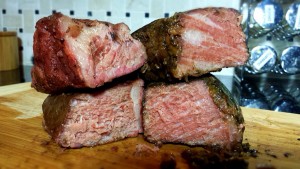 What else? Last night I made short ribs. Nom nom nom! I took beef short ribs from the freezer, and put them into the sous vide at 130. I had read that it takes 130 degrees to melt the collagen in the ribs. Then I went to Crossfit, etc. I came home, and the ribs were defrosted and held at 130 degrees.
What else? Last night I made short ribs. Nom nom nom! I took beef short ribs from the freezer, and put them into the sous vide at 130. I had read that it takes 130 degrees to melt the collagen in the ribs. Then I went to Crossfit, etc. I came home, and the ribs were defrosted and held at 130 degrees.
Then, I added a marinade made of coconut aminos, ginger, garlic, pumpkin seed oil, etc. to the baggie, sucked the  air out of the Ziploc again, and threw it back in the water. Went about my business for a few hours. When it was time to get cooking, I made some broccoli, sweet potatoes, etc.
air out of the Ziploc again, and threw it back in the water. Went about my business for a few hours. When it was time to get cooking, I made some broccoli, sweet potatoes, etc.
At about 45 minutes from wanting to get supper on the table, I pulled out the pressure cooker, sauteed some onions and bacon in the bottom using the “Saute” setting, then took them out, pulled the short ribs out of the sous vide, and seared the fat side in the pressure cooker. Once they had a nice crust (a couple of minutes), I put the onions/bacon back in, added the marinade from the Ziploc, sealed up the pressure cooker, and 30 minutes later – voila! Perfect, fork tender short ribs.
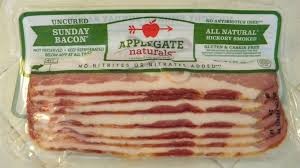 Oh, and – back at the bacon part – I discovered that I’d forgotten to take the bacon out of the freezer – so I actually took the vacuum-sealed pouch the bacon comes in, and just put it into the 130 degree water (with the packet of ribs) while I was chopping the onions. When it was time to do the bacon in the oven, it was defrosted and already par-cooked. The par-cooking kept the bacon flat and the fat from curling (who knew?)
Oh, and – back at the bacon part – I discovered that I’d forgotten to take the bacon out of the freezer – so I actually took the vacuum-sealed pouch the bacon comes in, and just put it into the 130 degree water (with the packet of ribs) while I was chopping the onions. When it was time to do the bacon in the oven, it was defrosted and already par-cooked. The par-cooking kept the bacon flat and the fat from curling (who knew?)
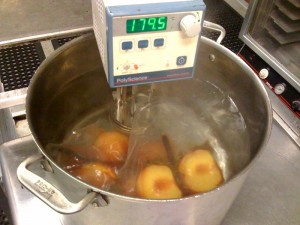 When I took the cooking class I mentioned above, we actually even made dessert in the sous vide (cooked peaches were the base of the dessert). It’s also the way to get perfect corn on the cob if that’s something you eat. You just put the ears into a Ziploc big enough for them, add butter, salt, a little tequila (smile), squeeze out all the air, and throw them into the water bath. They come out perfectly cooked, and the butter/salt/tequila has “marinated into” the corn.
When I took the cooking class I mentioned above, we actually even made dessert in the sous vide (cooked peaches were the base of the dessert). It’s also the way to get perfect corn on the cob if that’s something you eat. You just put the ears into a Ziploc big enough for them, add butter, salt, a little tequila (smile), squeeze out all the air, and throw them into the water bath. They come out perfectly cooked, and the butter/salt/tequila has “marinated into” the corn.
What you can cook with it is basically only limited by your imagination.
 For those of you who are pushed for time and want something ridiculously easy – but are tired of crock pot meals – you might want to check this out.
For those of you who are pushed for time and want something ridiculously easy – but are tired of crock pot meals – you might want to check this out.
Tonight? Bacon wrapped filet, anyone?
In case you’re curious, HERE is a link to an Anova. I personally do not set the time on mine (mine is a previous generation – you can see it in the photo above, in the pot). I just let it run, then when I take the meat or meal out, I unplug it. If you watch the video that is on the left of the linked page, it shows the cook first using a fancy vacuum sealer (for the meat) but then shows her doing the zucchini in a Ziploc. She puts the Ziploc into water, and then pushes the veg under the water and seals the Ziploc outside the water, using displacement to be sure she gets all the air out. You don’t want the baggies to float, and you want to be sure that the water touches the food (via the plastic). Otherwise, you won’t get the perfect temperature in the food because the air will act as an insulator. (NOTE: Do I ALWAYS get all the air out? Nope. If the baggie floats, I put a weight on it. And even if there is a little air in the bag, I figure that it’s going to get close to the temperature that I’ve set. Haven’t had a bad result yet.)

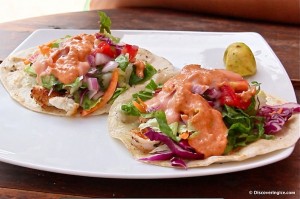
Nice article. I am new to sous vide as well.
Those ribs look wonderful
thanks Helen! I’m still having a blast with it – you can even do some desserts (as in, “stewing” fruit down, etc.) – I think I have “Sous Vide” madness! :-) Sandy